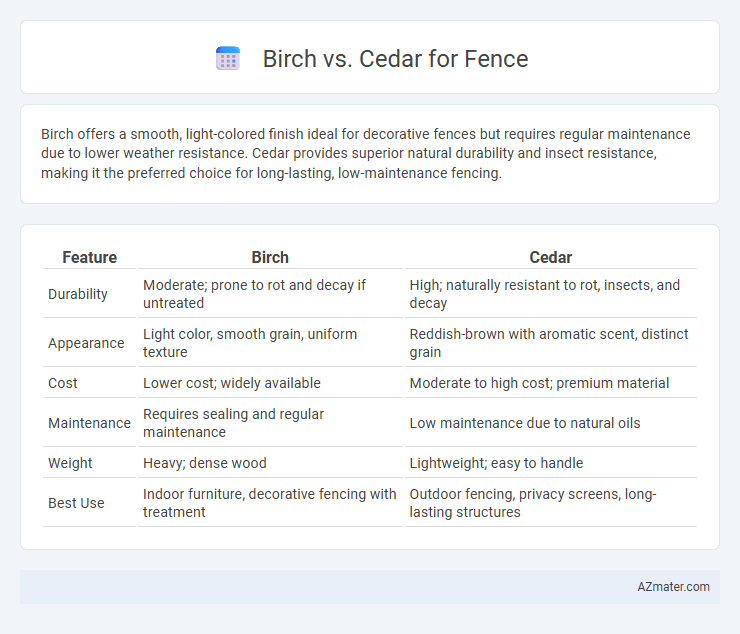Birch offers a smooth, light-colored finish ideal for decorative fences but requires regular maintenance due to lower weather resistance. Cedar provides superior natural durability and insect resistance, making it the preferred choice for long-lasting, low-maintenance fencing.
Table of Comparison
| Feature | Birch | Cedar |
|---|---|---|
| Durability | Moderate; prone to rot and decay if untreated | High; naturally resistant to rot, insects, and decay |
| Appearance | Light color, smooth grain, uniform texture | Reddish-brown with aromatic scent, distinct grain |
| Cost | Lower cost; widely available | Moderate to high cost; premium material |
| Maintenance | Requires sealing and regular maintenance | Low maintenance due to natural oils |
| Weight | Heavy; dense wood | Lightweight; easy to handle |
| Best Use | Indoor furniture, decorative fencing with treatment | Outdoor fencing, privacy screens, long-lasting structures |
Introduction to Birch and Cedar Fencing
Birch fencing offers a smooth, light-colored wood known for its fine grain and durability, making it an attractive option for decorative and privacy fences. Cedar fencing is prized for its natural resistance to decay and insects, featuring rich reddish hues and aromatic properties that enhance its longevity. Both woods provide distinct aesthetic and functional benefits, influencing choice based on climate, maintenance, and design preferences.
Wood Characteristics: Birch vs Cedar
Birch wood is dense and hard with a fine, even grain that offers a smooth surface but tends to be less durable outdoors without proper treatment. Cedar features natural oils that provide excellent resistance to decay, insects, and moisture, making it an ideal choice for fencing in various climates. Comparing wood characteristics, cedar's lightweight and weather-resistant properties outperform birch for long-lasting fence applications.
Durability and Lifespan Comparison
Birch wood fence panels offer moderate durability with a natural resistance to rot and decay, lasting approximately 15-20 years when properly treated and maintained. Cedar fences are renowned for their exceptional durability, featuring natural oils that repel insects and moisture, which extends their lifespan up to 30 years or more. The choice between birch and cedar significantly impacts long-term fence performance, with cedar being the superior option for longevity and minimal maintenance.
Resistance to Decay and Insects
Birch wood generally has lower resistance to decay and insects compared to cedar, making it less durable for outdoor fencing without proper treatment. Cedar naturally contains oils and compounds that repel moisture and pests, providing superior durability and minimal maintenance over time. Choosing cedar for fencing ensures enhanced longevity and reduced risk of rot and insect damage, especially in humid or pest-prone environments.
Maintenance Requirements
Birch fences require regular sealing and staining due to their susceptibility to moisture damage and decay, demanding consistent upkeep to prevent warping and rot. Cedar fences are naturally resistant to insects and decay, significantly reducing the need for frequent maintenance and treatments. Choosing cedar lowers long-term maintenance efforts compared to birch, making it a popular option for durable fencing with minimal care.
Aesthetic Appeal and Color
Birch fences offer a light, pale tone with smooth grain that brightens outdoor spaces and complements modern or Scandinavian-style landscapes. Cedar fences provide rich, warm hues ranging from reddish-brown to amber, adding natural depth and rustic charm ideal for traditional or country aesthetics. Over time, cedar develops a silver-gray patina that enhances its character, while birch maintains a lighter, more uniform color but may require treatments to prevent fading.
Cost Differences
Birch fencing typically costs more upfront due to its higher-quality grain and durability, averaging between $25 and $35 per linear foot, while cedar fences range from $15 to $30 per linear foot, making cedar the more budget-friendly option. Maintenance expenses for birch fences can increase over time as they are less naturally resistant to rot and insects compared to cedar, which contains natural oils that enhance its longevity and reduce upkeep costs. Considering both initial investment and long-term maintenance, cedar fencing offers a stronger cost advantage for budget-conscious homeowners seeking durability and aesthetic appeal.
Environmental Impact and Sustainability
Birch fences have a lower environmental impact due to faster growth rates and sustainable harvesting practices, promoting carbon sequestration and reducing deforestation. Cedar wood, while naturally resistant to decay and insects, takes longer to mature, which can lead to higher ecological costs if not sourced responsibly. Choosing sustainably certified birch or cedar ensures durability and minimizes carbon footprint, supporting long-term forest health and biodiversity.
Best Applications for Each Wood
Birch wood is best suited for interior fencing projects where smooth texture and fine grain enhance aesthetic appeal, making it ideal for decorative or light-use partitions. Cedar excels in outdoor fencing due to its natural resistance to moisture, insects, and decay, offering durability and low maintenance in harsh weather conditions. Choosing cedar ensures longevity and structural integrity, while birch provides a polished, refined look in controlled environments.
Final Recommendation: Choosing the Right Fence Material
Birch offers a smooth, pale finish ideal for decorative fencing but requires regular maintenance to prevent rot and insect damage. Cedar provides natural resistance to moisture and pests, ensuring durability and minimal upkeep, making it well-suited for long-lasting outdoor fences. For those prioritizing longevity and weather resistance, cedar is the recommended choice, while birch suits aesthetic-focused projects with careful maintenance.

Infographic: Birch vs Cedar for Fence
 azmater.com
azmater.com